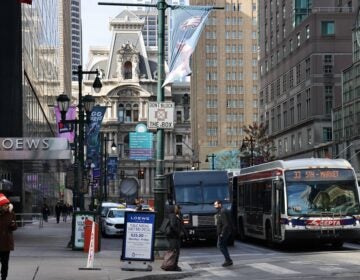Northwest Philadelphia a key spot for city’s mid-winter bird census
Diligence, taking the form of two and-a-half minutes of whistling, was rewarded early Saturday morning with a feint quiver.
Facing the equestrian facility on Northwestern Avenue in Chestnut Hill at quarter to five in the morning, Keith Russell imitated the sound of a screech owl.
Because of the stable’s hay, Russell figured that mice – as well their predators – would likely be attracted to the building.
When the suspected owl responded to Russell’s overture, it was the sixth such bird to do so in the opening hours of the Philadelphia Mid-Winter Bird Census, which brought together dozens of birders from across the region to identify and tally winged species in the city.
The suburbs aren’t included in this count.
Hearing the owl’s call, census participant Shawn Towey remarked, “It was a good thing it was on this side of the street or we couldn’t count it.”
An annual tradition
This weekend marked the 27th annual mid-winter census, which in addition to locating, identifying, and counting birds in Philadelphia, offers ornithologists and others the opportunity to monitor the change in bird populations over longer periods of time.
It’s the only such monitoring effort in Philadelphia County, parts of which – Fairmount Park and the John Heinz National Wildlife Refuge – were declared an “Important Bird Area” by the National Audubon Society in 2008.
There are 85 such areas state-wide. They’re defined as providing essential habitats to one or more species of bird, and meet a set of criteria related to the vulnerability of the bird population therein.
Russell, a Germantown resident whose calls would bring forth many birds throughout the day, is the Philadelphia Bird Census Coordinator and a Science and Outreach Coordinator for the National Audubon Society (NAS). He has a reputation for being one of the leading birders in Philadelphia.
Russell first became interested in birds as a student at Henry Elementary School in Mount Airy. And while he can’t recall a precipitating event or individual that triggered his curiosity, he related that his youthful enthusiasm has resulted in a lifetime of satisfaction and learning.
Birding goes high-tech
Saturday’s census began shortly after at 4 a.m., on McCallum Street in Germantown. There Russell started trying to locate the first bird of the day.
With nearby Tulpehocken Street yielding little, Russell headed to Carpenter’s Woods in Mount Airy, where two screech owls were identified by sound. While sight is the preferred method of identification, aural recognition is acceptable for inclusion in the census.
And while having good eyes and trained ears are important skills, the birders’ toolkit has evolved beyond a trusty set of binoculars: online databases and smart phone applications are now allowing more and more people to leave their field guide at home and help locate bird “hot spots.”
eBird, a real-time, online checklist program launched in 2002 by the Cornell Lab of Ornithology and the NAS, provides data for bird abundance and distribution, boasting as many as 3.1 million bird observations in North America in one month in 2012 alone.
iBird is a smartphone application which incorporates a “decision engine” to assist in the on-site identification of species.
While Russell said that he is not “technologically up,” he noted that these tools, along with social networking, are allowing birders to share their finds faster, more scientifically, and with a broader range of people.
‘Conducting without a score’
With thirteen owls recorded by 6:30 a.m. in various locations across Northwest Philadelphia, Russell and his two assistants abandon both this species and this section of the city for the industrial wastelands located along the Delaware River near the mouth the Frankford Creek in Northeast Philadelphia.
“It’s pretty scrappy, isn’t it?” said Russell of the garbage-stern plot beneath the Tacony-Palmyra Bridge.The setting, made even more glum by overcast skies and the murkiness of the Delaware, yielded a myriad of birds, including white sparrows, Greater Scaups, Bufflehead ducks, and both Great and Double-crested cormorants, a sea-bird.
Returning to the car, Russell added his findings to a spreadsheet for the first time, four hours after the census had kicked off.
Asked how he kept so many different strands of information in mind, Russell laughed and responded, simply, “I remember.”
“It’s like conducting (an orchestra) without a score,” he said. “You know what notes are coming.”
And while the bird census isn’t yet complete – it will take several weeks to tally the responses of volunteers and reconcile overlaps – two-thirds of approximately 65 census participants have reported their results, with between 25,000 to 35,000 birds expected in the count.
So far, 106 species have been observed, just shy of the all-time high of 109, and one of only four times so many have been identified in the census’ 27-year history.
“Philadelphia has a lot of variety in terms of bird life,” he observed, noting that Philadelphia’s species count often bests those of rural areas.
“It’s a thing a lot of people don’t know or appreciate,” he said. “It’s a feather in our cap.”
An unusual sight
As he left the river for a nearby railway bed that borders the Northeast Wastewater Treatment Plant, Russell happened upon a fellow group of birders who were there to witness one of the more beguiling discoveries of recent bird counts: a group of swallows who, opting out of traditional seasonal habitats in Mexico and Texas, have chosen to spend their winter at a Philadelphia sewage facility.
“In the bird world, that’s big news,” quipped Russell.
While the reasons for the change in migratory patterns is something of a mystery – the small flies known as “midges” that swarm the sewage beds and provide the birds with sustenance are part of the answer – the birders’ reasons for being there is not.
Frank Windfelder, former president of the Delaware Valley Ornithological Club, shared from his post not far from the sewage plant that “birders are a pretty loose group.”
“If you get into this, it grips you,” he said. “I love it.”
WHYY is your source for fact-based, in-depth journalism and information. As a nonprofit organization, we rely on financial support from readers like you. Please give today.




